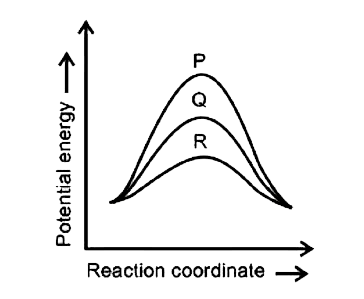If a homogeneous catalytic reaction can take place through three alternative paths as depicted below, the catalytic efficiency of P,Q R representing the relative case would be

P>Q>R
Q>P>R
P>R>Q
R>Q>P
The correct Answer is:D
The order of required activation energy is R<Q<P so the catalytic efficiency would be R>Q>P .
Topper's Solved these Questions
- CHEMICAL KINETICSBOOK - ERRORLESSCHAPTER - CHEMICAL KINETICSEXERCISE - NCERT BASED QUESTIONS (Photochemical Reaction)
4 Videos
- CHEMICAL KINETICSBOOK - ERRORLESSCHAPTER - CHEMICAL KINETICSEXERCISE - NCERT BASED QUESTIONS (Graphical Questions)
7 Videos
- CHEMICAL KINETICSBOOK - ERRORLESSCHAPTER - CHEMICAL KINETICSEXERCISE - NCERT BASED QUESTIONS (Rate Law and Rate Constant)
106 Videos
- CARBOXYLIC ACIDSBOOK - ERRORLESSCHAPTER - CARBOXYLIC ACIDSEXERCISE - Assertion & Reason
5 Videos
- CHEMISTRY IN EVERYDAY LIFE BOOK - ERRORLESSCHAPTER - CHEMISTRY IN EVERYDAY LIFE EXERCISE - Assertion & Reason
4 Videos
Similar Questions
If a homogeneous catalytic reaction follows three alternative paths A, B and C, then which of the following indicates the relative ease with which the reaction moves?

View SolutionSubstances which alter the velocity of a reaction by mere presence, without undergoing any change in mass and compossition are termed catalyst and the phenomenon is known as catalysis
In homogenous catalytic reactions, there are three alternative paths A, B, and C (shown in figure). Which one of the following indicates the relative ease with which the reaction can take place?

View Solution
Knowledge Check
If a homogeneous catalytic reaction can take place through three alternative paths as depicated below, the catalytic efficiency of P , Q, R representing the relative case would be,
 AP>Q>RBQ>P>RCP>R>QDR>Q>P
AP>Q>RBQ>P>RCP>R>QDR>Q>PA homogenous catalytic reaction takes place through the three alternative plots A, B, and C shown in the given figure. Which one of the following indicates the relative ease with which the reaction cant take place?
 AA>B>CBC>B>ACA>C>BDA = B = C
AA>B>CBC>B>ACA>C>BDA = B = CA homogenous catalytic reaction takes place through the three alternative plots A, B, and C shown in the given figure. Which one of the following indicates the relative ease with which the reaction cant take place?
 AA>B>CBC>B>ACA>C>BDA=B=C
AA>B>CBC>B>ACA>C>BDA=B=C
Assertion (A): A certain recation is catalysed by acids and the catalytic activity of 0.1M solutions of the acids in water decrease in the order, HCI,HCOOH, and CH3COOH. The same reaction takes place in anhydrous NH3, but the three acids have same catalytic effect in 0.1M solution.
Reason (R) : The order of catalytic activity in water is the same as the order of acidity. in anhyrous NH3, all the three acids are strong.
View SolutionOrganic reactions take place through the formations of reactive carbon intermediates formed by cleavage of covalent bonds. Formation of these intermediates depends upon the dissociation energies of covalent bonds.
In which cases, free radicals can be formed by homolytic fission ?
View SolutionOrganic reactions take place through the formations of reactive carbon intermediates formed by cleavage of covalent bonds. Formation of these intermediates depends upon the dissociation energies of covalent bonds.
3. In the following diagram, stability of different radicals have been represented. These can be

Match the potential curve with free radical

View SolutionHydrogenation of alkenes and alkynes takes place in presence of certain catalysts. In Sabatier Senderen's reaction, the addition of hydrogen takes place I presence of Raney nickel catalyst. Platininm and palladium can also be used as catalyst and used in finley divided state. Experimentally, it is observed that less crowded alkenes adsorb H2 with faster rate. Controlled hydrogenation of alkyne H2 with faster rate. Controlled hydrogenation of alkyne in presence of Lindlar's catalyst yields cis product i.e., 'cis' alkene. Thus, in presence of Lindlar's catalyst 'syn' addition takes place. The relative rate of hydrogenation follows the order:

Non-terminal alkynes are reduced in presence of Na or Li metal dissolved in liquid ammonia. In this reaction, anti-addition of hydrogen results into the trans-product.
Answer the following questions:
The relative rate of catalytic hydrogenation of following alkenes is:

View SolutionCatalytic hydrogenation involves addition of hydrogen to a gt C = Clt or -C ≡ C- bond in presence of a metal catalyst such as Ni, Pt, Pd, etc. These are called heterogeneous catalysts. Both H2 and alkene/alkyne get adsorbed on the surface of the metal , and syn-addition of hydrogen atoms takes place. The relative rates of hydrogenation follows the order:
−C≡C−>>C=C<>C=o<C6H6
If sodium or lithium in liquid ammonia is used, anti-addition of H-atoms occurs across −C≡C−bond. These reducing agents can also be used to reduce double bonds of benzene rings and conjugated dienes but not of isolated dienes.
Which of the following alkenes will react most readily with H2 under catalytic hydrogeneration conditions ?
View Solution
